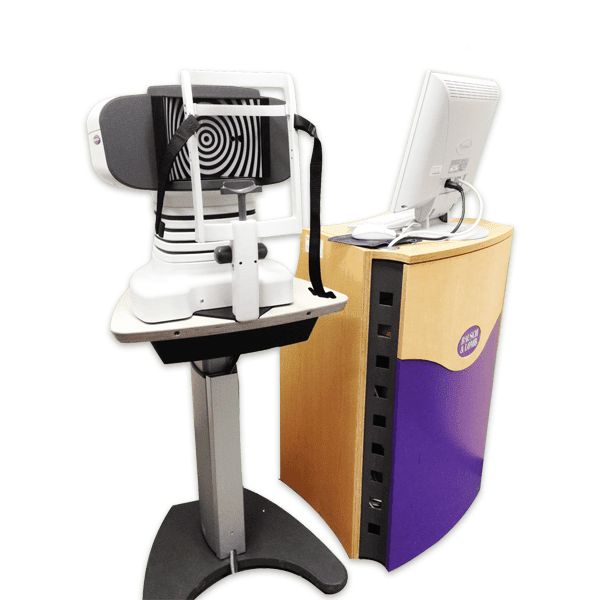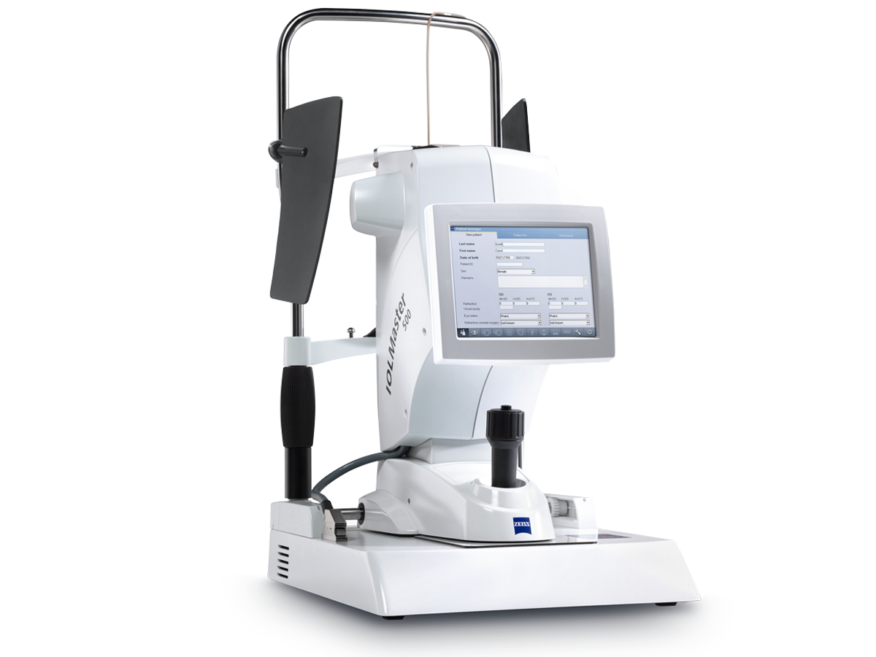Diagnostic Technology
State-of-the-art
Diagnostic Technology
Did you know that one of the most important steps to a successful eye surgery is optimal candidate and surgery selection? The CODET Patient Selection System is a detailed visual diagnostic test and patient selection method designed to produce the best visual results and satisfied patients.
Cutting-edge Equipment for Accurate Visual Diagnostics
Our diagnostics technology consists of a second-to-none optometry department, responsible for efficiently performing an extensive battery of visual diagnostic tests to produce a thorough assessment of a patient’s surgical candidacy. It’s operated by a highly experienced and trained staff of optometrists that walk you through the entire process and culmintates with our expert surgeons selecting the best path forward for our patients.
Learn more about our diagnostics equipment:

Heidelberg, Germany
Anterion
The most advanced diagnostic equipment for the Anterior Segment, now at CODET Vision Institute. An essential technology element which transforms the day-to-day routines in cataract and refractive surgery, cornea and glaucoma diagnostics.
Benefits and highlights:
- The Anterion utilizes the power of high-resolution swept-source OCT images to provide the most important anterior segment examinations and measurements in one platform.
- An all-in-one efficient solution that combines: Corneal topography and tomography, anterior segment metrics, axial length measurement and IOL calculation.
- Delivers high-quality images and comprehensive measurements while minimizing the time needed to perform multiple anterior segment examinations.
- Visual confirmation of all measurements with high-resolution swept-source OCT images provides diagnostic confidence.
- CODET Vision Institute is one of the few centers in Mexico, and the only eye institute in Baja California, that utilizes the Anterion.

Oculus, Germany
Corvis ST
Corneal biomechanics are critically relevant to intraocular pressure readings, development of ectasia, and in refractive surgical interventions. The Corvis ST allows for comprehensive diagnostics over interrelated measurements at second-to-none quality.
Benefits and highlights:
- Biomechanical ectasia detection. In a very early stage, even when other equipment is not able to detect it, CORVIS will
- Follow-up after cross-linking
- High pressure IOP measurements
- Glaucoma screening based on biomechanics
- CODET Vision Institute is one of the few centers in Mexico, and the only eye institute in Baja California, that utilizes the Corvis.

Heidelberg, Germany
Spectralis
Multimodal imaging platform optimized for the posterior segment. Diagnostic imaging platform which combines scanning laser fundus imaging with high-resolution OCT.
Benefits and highlights:
- Diagnosis of diseases in very early stage of the disease improving the outcome of the treatment.
- Gold standard, novel technology.
- Multimodal imaging options include: OCT, multiple scanning laser fundus imaging modalities, widefield and ultra-widefield, scanning laser angiography, and OCT angiography.
- Configured to CODET practice diagnostic workflow.

Visometric, Spain
HD Analyzer
An essential diagnostic tool that can pre-diagnose the subtle, forward light scatter that affects surgical outcomes for cataract and refractive patients. It can also check for Dry Eye diseases and early Cataracts.
Patients can have 20/20 visual acuity, but that does not guarantee vision quality. The HD Analyzer, based on the double-pass technique, assesses optical quality objectively by measuring light scattering, among other metrics, that we use to identify the right procedures for each patient.
Benefits and highlights:
- Accounts for light scatter in ways other technologies can’t.
- Meet the patient’s expectations with an objective report of the entire visual system.
- Demonstrates to patients, and family, objective visual loss due to cataracts and poor tear film.
- Helps Identified LASIK candidates by ensuring patients have clear optics and stable vision.
- Ensures great outcomes for cataract and lens exchange surgery by eliminating dry eye disease as a source of visual disturbance.

Alcon, United States
WaveLight Topolyzer Vario
The most advanced technology in corneal mapping-topography, that integrates non-contact topography, keratometry, and pupillometry in a single device. For precise measurements and better results.
Benefits and highlights:
- A complete map of the cornea for precise control of the laser treatment.
- Visibility of visual defects with advanced, integrated mapping technology.
- CONTOURA® Vision capability, designed to provide surgeons the ability to perform more personalized laser procedures based on the unique corneal topography of each eye.

Oculus, Germany
Pentacam
Using the Pentacam from Oculus, we can measure the entire cornea without contact. Taking advantage of the Scheimplug principle and advanced neural network software (artificial intelligence), we can capture an overall view of the all-important anterior segment of the patient’s eye in a matter of seconds.
Benefits and highlights:
- The Gold standard diagnostic technology, for precise diagnostics data on the entire anterior eye segment.
- Fast Screening report and Scheimpflug Image Overview for an accurate diagnose of Keratoconus.
- Corneal pachymetry measures the cornea´s thickness, providing accurate measurements that help the surgeons select the best refractive surgery technique.
- The software offers a vast range of functions such as Virtual Eye, Tomography, Iris Image, Topometric, and Comparison displays.

NIDEK, Japan
OPD Scan
To meet our patient’s specific needs, we use the all-in-one refractive workstation, the OPD Scan, that provides us with detailed scans of the corneal topography, wavefront, autorefraction, keratometry, and pupillometry. Ensures accurate and useful refractive diagnosis that optimizes cataract and refractive outcomes.
Benefits and highlights:
- State-of-the-art imaging and analysis technology, developed to measure normal to higher-order aberrated eyes.
- Delivers a wide variety of data maps to provide information on total refractive error, wavefront, corneal shape, internal aberrations, and visual quality of the eye.
- Detailed patient summaries for optics diagnosis.

Bausch and Lomb, United States
Orbscan
The Orbscan corneal topography system traces a map of the patient’s corneal surface with the use of Plácido’s ring technology, creating a Cornea and Anterior eye assessment that allows surgeons to examine anterior and posterior astigmatism and optical pachymetry. This information allows us to select ideal patients for refractive surgery.
Benefits and highlights:
- Identifies the location of irregularities that cause corneal refractive errors, which causes poor eyesight.

NIDEK, Japan
Refraction Workstation COS-2000
First-class technology combines the power of lensectometry, refractometry and subjective visual tests, to calculate approximate high-order refractive errors that cause poor eyesight.
Benefits and highlights:
- Accurately indicates the amount of nearsightedness, farsightedness and astigmatism of patients.
- Provides the specialist the best refractive result that refractometry, to obtain better visual acuity.
- Measures the actual lens prescription on patients by calculating the number of diopters by the lensometer.
- Combining this information, along with the proper medical assessment, allows doctors to estimate the patient´s refractive stability through time.

Zeiss, Germany
IOL Master
The gold standard in Optical biometry, our Zeiss IOL Master 500 is in a class of equipment that has produced more than 100 million successful IOL power calculations as of 2020.
Benefits and highlights:
- Refractive outcomes surgeons and patients can trust
- Fast, accurate, and offers advanced measurements of challenging eyes
- Precise, efficient, toric IOL alignment

Lombart, United States
Ultrasound Mode B VuPad
The VuPad ultrasound is a new class of ophthalmic ultrasound versatility, It is configurable with B-scan, A-scan, UBM, Pachymetry, or any combination.
Benefits and highlights:
- Ultrasonic B retina images are a big aid for retina doctors in the diagnosis and treatment of retina conditions.
- Diagnostic of retina’s detachments when other methods of diagnosis are not able to do it.
- Also serves to confirm diagnosis and best surgical approach.
- Truly outstanding image quality and elegant user interface.

NIDEK, Japan
AFC 330 NON MYD Fundus Camera
The latest in retinal imaging technology, the AFC-330 breaks new ground in fundus photography with emphasis on the reliability on the image taken. The new standard in speed, automation, and accuracy.
Benefits and highlights:
- Fast and easy takes- for patient comfort compare with other systems
- X-Y-Z auto alignment – quality in the pictures of the back of the eye (fundus in the retina)
- Panoramic (stereo photography) to capture as much as data as possible for the surgeon to assess the back of the eye.